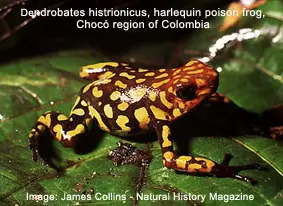 Will climate change spell the extinction of Harlequin Frogs?
Will climate change spell the extinction of Harlequin Frogs?
At least 110 species of brightly coloured harlequin frogs once lived near streams in the tropics of Central and South America, but about two-thirds vanished in the 1980s and 1990s. With the Earth likely to become warmer than at any period in the past 1-40Myr,anthropogenic climate change could act as a major cause of extinctions in the near future.
Scientists use records of sea-surface and air temperatures, and have shown that harlequin frogs are dying in near lockstep with changing climate conditions in their environment.
According to scientists, Earth’s rising temperature enhances cloud cover on tropical mountains, leading to cooler days and warmer nights, both of which favour proliferation of the chytrid fungus, and could mean the extinction of harlequin frogs.
 Chytrid Fungus
Chytrid Fungus
The chytrids are the most primitive of the fungi and are mostly saprobic (degrading chitin and keratin). Many chytrids are found in fresh water, and there are approximately 1,000 chytrid species, in 127 genera, distributed among 5 orders. Some chytrid species are known to kill amphibians in large numbers. The actual process, however, is unknown. The infection is referred to as chytridiomycosis. Decline in frog populations led to the discovery of chytridomycosis in 1998 in Australia and Panama (also see the Gastric Brooding frog).
Biologist – James Collins
“In the tropical cloud forests of Costa Rica and Panama, at altitudes between about 5,000 to 9,000 feet, global warming poses a clear threat to the local ecosystem. Changing climate alters the patterns of temperature, mist, and rainfall, causing cloud banks to form at increasing elevations, and compressing the possible range for cloud forests.
Such a clear causal relation makes the cloud forests excellent natural laboratories for studying the effects of global warming on amphibians. The amphibians living there are often supported by the water in the clouds. And sure enough, frog populations in cloud forests have significantly declined, and a number of species have become extinct.
Nevertheless, rising temperatures per se don’t seem to be killing the amphibians. What is happening instead, according to investigators such as Allen Pounds of the Tropical Science Center in San José, Costa Rica, and his colleagues, is that by narrowing the range of cloud forests, global warming could be forcing populations of amphibians to live together so densely that they become more susceptible to stresses such as disease-causing pathogens.
Global warming is also making the cloud-forest habitat so attractive to species from lower elevations that they are invading and could threaten the amphibian communities.” Collins, J.P. 2004 Where Have All the Frogs Gone? Biologists have examined a rogues’ gallery of possible culprits:A leading suspect is an infective fungus, Natural History Magazine.
 Fungus or Starvation?
Fungus or Starvation?
The massive decline of frog populations in particular has been widely linked to a fungus which can wipe out a species in months. However, a new study has also found slow, steady declines of both lizards and frogs in pristine, protected rain forests that are free of fungus.
“There was no reason that these species should be in decline. Populations in the lowlands of Central America were thought to be free of risk,” said Steven M. Whitfield of Florida International University, the lead author of a study into the extinction of harlequin frogs.
The new study, published in the current issue of the Proceeedings of the National Academy of Sciences, reviewed data collected over 35 years at La Selva Biological Station in Costa Rica. These scientists found a 75 percent drop in local amphibian and reptile numbers during that period. Not only is the fungus absent at La Selva, but it doesn’t appear to affect reptiles at all, so another factor is thought to be the blame for the drop in numbers.
The study suggests that increased rain and higher temperatures observed over the same 35-year period may be responsible for the trend towards the extinction of harlequin frogs. Whitfield thinks that hotter, wetter conditions speed decomposition of the fallen leaves that the animals depend on for their habitat. He sees this as particularly alarming, because the species are going extinct rapidly, and even in areas where there appears to be no human impact.
There are so many ecosystem relationships that we do not fully understand, but what we do know from observations is that anthropogenic climate change and human impact is devastating our natural Earth systems. Like the demise of the Golden Toad, our actions appear to be leading to yet another unforseen impact, the extinction of Harlequin Frogs.
|
Other Species Impacted Upon by Climate Change
Quiver Tree |
